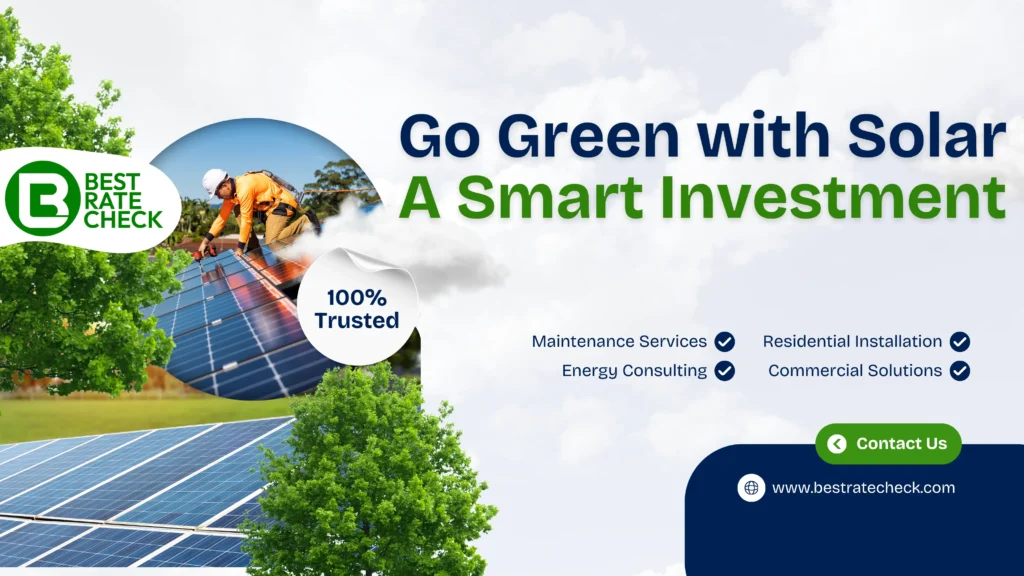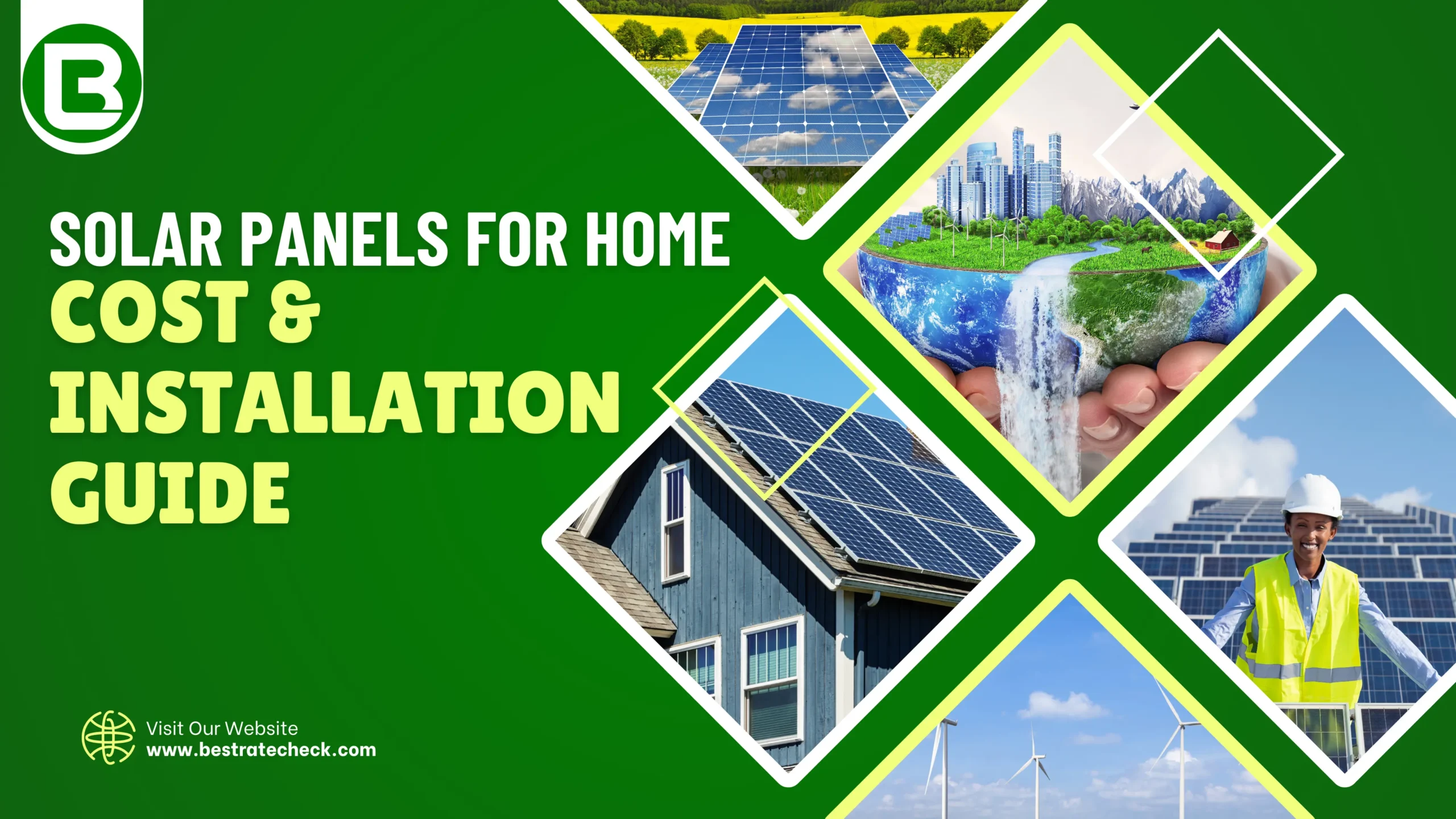Do you feel like you’ve been paying a lot for your electricity bills lately? Planning to switch to solar panels for home? We can help you compare and choose the right option for your needs—whether you should install solar panels at your home, or keep using electricity from the grid.
First of all, your family’s energy consumption patterns depend on a lot of factors. The size of your house, number of electrical appliances, how energy-efficient they are, the climate where you live; all of this matters. On an average, a U.S. household spends $191 per month on electricity.
If all utilities combined aren’t costing you more than 10% of your annual income, you have nothing to worry about. It’s common to spend at least this much. Moreover, if you’re a freelancer who works from home, it is natural to spend more on electricity than others do.
In this guide, we’re going to explore the cost of solar panels, how they compare to using normal electricity, affordable sources to buy them from, and other common questions related to solar energy. We’ll cover everything in detail so you can make the correct choice.
What is Solar Power?
Before we get into the costs of installing a solar panel at your house, let’s understand what solar power means. Some of you may already know how it works. It is energy from the Sun which gets converted to electricity. It is the cleanest, most abundant energy source available on Earth.
Solar energy is never going to run out. The Sun won’t simply stop existing, and if someday it does, we all will die. Then there’s no point in worrying about your bills right? Kidding! The point is, solar power has the potential to satisfy all our future energy needs because we get it every single day.
Some of the most basic requirements like light, heating water, or even powering your entire home can be fulfilled without issues. For small scale usage like households, photovoltaic (PV) devices or solar cells are used. They come in different wattages, and you can choose one according to your needs.
Types of Solar Panels for Home
There are three major types of solar panels—monocrystalline, polycrystalline, and thin-film. Out of these, mono- and poly- solar panels are well-suited for residential use. They all differ in their efficiencies, cost, and required area:
- Monocrystalline: Most efficient, sleek in appearance, idea for limited roof spaces.
- Polycrystalline: Affordable, slightly less efficient, but cost-effective.
- Thin-film: Least efficient, requires more space, lightweight, high-temperature-friendly.
Are Solar Panels Cheap or Expensive?
Solar panels are both cheap and expensive. Depending on the context, and the provider you choose, the cost of solar panels varies greatly. By themselves, solar panels are not that expensive. Some models even cost as low as $1.25 per watt. But, the total cost can be pricey.
For example, if you add up the installation cost and other components like inverters, the cost goes up to $20,552 or even $30,000. It is also important to note that this is just a one-time expense. Currently, nearly 4 percent of U.S. homes have solar panels on their rooftops.
Government incentives have made solar more accessible and affordable. The cost of solar has already dropped by 70 percent in the past decade and on top of that, homeowners can qualify for a 30% Solar Investment Tax Credit (ITC) if they’re installing a solar system before 2032 ends.
So, it is all about the perception of cost. Houses with solar also go up in value by $15,000. If you’re saving a lot in the long term, it might be worth considering switching.
How Much Do Solar Panels Cost?
On average, solar panels for homes cost between $18,000 and $43,000. The most deciding factors are the type of panels, your location, and the size of your solar system.
Here are the average solar panel prices based on their type:
| Panel Type | Cost per Watt |
| Monocrystalline | $1.00 to $1.50 |
| Polycrystalline | $0.90 to $1.50 |
| Thin-film | $0.50 to $1.50 |
We’ve given a detailed breakdown of how much solar panels cost for different system sizes:
| System Size (kW) | Price Range(Before Incentives) |
| 3 kW | $7,800 - $9,600 |
| 4 kW | $10,400 - $13,040 |
| 5 kW | $12,800 - $13,400 |
| 6 kW | $15,600 - $17,340 |
| 7 kW | $18,400 - $19,670 |
| 8 kW | $21,200 - $22,160 |
| 9 kW | $24,000 - $25,110 |
| 10 kW | $26,000 - $27,300 |
| 11 kW | $29,000 - $29,810 |
| 15 kW | $38,000 or more |
Total Cost of Installing Solar System by State
Some states have lower installation and labor costs. Plus, the federal incentives and deductions also vary by state. Not only does your location influence these upfront costs, it decides how much you’ll actually be saving by choosing solar. That’s because electricity costs also differ in each state.
| U.S. State | Cost After Incentives | Avg. Cost/Watt | Time for ROI |
| South Dakota | $16,016 | $2.29 | 10 years, 5 months |
| Alaska | $16,142 | $2.31 | 10 years |
| Montana | $16,268 | $2.32 | 13 years, 2 months |
| North Dakota | $16,268 | $2.32 | 11 years, 1 month |
| Alabama | $16,457 | $2.35 | 8 years, 2 months |
| Arizona | $16,080 | $2.44 | 9 years, 8 months |
| Wyoming | $17,213 | $2.46 | 14 years, 6 months |
| Florida | $17,710 | $2.53 | 9 years, 7 months |
| Mississippi | $17,717 | $2.53 | 10 years |
| Hawaii | $12,906 | $2.56 | 4 years, 10 months |
| Oklahoma | $17,920 | $2.56 | 10 years, 5 months |
| Nevada | $17,990 | $2.57 | 11 years, 7 months |
| Utah | $18,340 | $2.62 | 18 years |
| Texas | $18,480 | $2.64 | 9 years, 6 months |
| Nebraska | $18,977 | $2.71 | 14 years, 1 month |
| Ohio | $19,250 | $2.75 | 13 years, 3 months |
| North Carolina | $19,460 | $2.78 | 13 years |
| South Carolina | $12,600 | $2.80 | 7 years, 1 month |
| Missouri | $19,740 | $2.82 | 13 years |
| Arkansas | $19,950 | $2.85 | 12 years, 5 months |
| Delaware | $19,950 | $2.85 | 12 years, 11 months |
| West Virginia | $19,950 | $2.85 | 11 years, 8 months |
| Kansas | $20,090 | $2.87 | 12 years, 11 months |
| Georgia | $20,650 | $2.95 | 11 years, 5 months |
| New Jersey | $21,000 | $3.00 | 15 years, 4 months |
| Idaho | $21,070 | $3.01 | 16 years, 10 months |
| Maryland | $21,070 | $3.01 | 12 years, 7 months |
| Virginia | $21,280 | $3.04 | 12 years, 3 months |
| Oregon | $21,350 | $3.05 | 16 years, 6 months |
| Pennsylvania | $21,350 | $3.05 | 13 years, 1 month |
| Washington | $21,350 | $3.05 | 17 years, 2 months |
| California | $21,420 | $3.06 | 12 years, 11 months |
| Louisiana | $22,050 | $3.15 | 11 years, 6 months |
| Illinois | $22,260 | $3.18 | 16 years, 5 months |
| Kentucky | $22,330 | $3.19 | 13 years, 2 months |
| Connecticut | $22,400 | $3.20 | 10 years, 7 months |
| Tennessee | $22,610 | $3.23 | 12 years, 11 months |
| New Mexico | $19,680 | $3.28 | 17 years, 12 months |
| Minnesota | $23,030 | $3.29 | 17 years, 5 months |
| Vermont | $23,100 | $3.30 | 17 years |
| Wisconsin | $23,380 | $3.34 | 18 years, 3 months |
| New York | $18,450 | $3.35 | 11 years, 9 months |
| Michigan | $23,590 | $3.37 | 16 years, 11 months |
| Colorado | $24,080 | $3.44 | 20 years, 5 months |
| Iowa | $24,430 | $3.49 | 17 years, 5 months |
| Massachusetts | $23,710 | $3.53 | 13 years, 2 months |
| Maine | $24,990 | $3.57 | 15 years, 11 months |
| Rhode Island | $25,270 | $3.61 | 15 years, 5 months |
| New Hampshire | $25,550 | $3.65 | 13 years, 5 months |
| Indiana | $25,620 | $3.66 | 15 years, 5 months |
Solar Energy vs. Electricity Costs
Shifting to using solar energy is no doubt a great investment. Here’s why:
| Factor | Solar Energy | Traditional Electricity |
| Initial Cost | $10,000-30,000 for installation Costs are reduced by incentives (e.g., 30% tax credit in the U.S.) | No installation fee; Paid via monthly bills (approx. $114/month) |
| Long-Term Cost (25 yrs) | $22,0000-32,500 (for 20-panel system) Effective cost of 12.15 cents/kWh | $40,800-51,300; Effective cost of 53 cents/kWh Rates fluctuate and are increasing 4% annually |
| Government Incentives | Benefits include tax credits, rebates, feed-in tariffs, and significant price drops (e.g., U.S. solar module prices fell by 78% between 2007–2015) | No direct incentives |
| Efficiency & Reliability | Solar panels convert 15–22% of sunlight; Pairing with battery storage gives a consistent, independent supply | Dependent on grid infrastructure |
| Environmental Impact | Renewable and clean | Generated from fossil fuels, contributes to pollution and climate change drastically |
Are Solar Panels Worth It?
If you’re spending so much, you must get returns out of your investment right? Sure, the upfront costs of installing solar panels is too high. But, if you end up saving more money in the longer run, then why not. Most homeowners find the purchase worth it due to long-term savings.
Once you get a solar system, the investment value will be paid off in about 7.1 years. After this point, all electricity generated is free. Over the span of 25 years, you can save anywhere between $31,000 and $120,000. Moreover, your house’s value increases by 6.8 percent.
Overall, households whose energy consumption is high can benefit from this long-term investment. Also, if the utility rates are higher where you live, solar panel installation can be worth it. For those who plan moving in the future, or don’t use much electricity, solar energy won’t be a smart move.
How to Choose the Right Rooftop System?
There are some key considerations that will help you decide on the right solar system for your use. Start with understanding what your monthly and annual electricity usage is. That comes first. Next, you should check your roof’s condition, age, and whether the structure is good enough for solar.
Type of Roof
For installing solar, south-facing roofs with a slope between 15 and 40 degrees are the best. Once this is sorted, you can move on to choosing between the two types of panels—monocrystalline and polycrystalline. It depends on your budget and roof size.
Solar Providers
Research to find reliable providers. Brands like Maxeon, REC, Panasonic, Canadian Solar, and Jinko are some of the best solar panel companies. To get affordable quotes from top local providers, compare offers with The Sun Saver for free. You’ll get the best solar panels, and never-ending customer support with the providers.
Inverters
Next, you need to decide between string inverters, microinverters, and power optimisers. Solar panels can only generate DC current using sunlight which has to be converted to AC. Otherwise, you won’t be able to enjoy electricity in rooms that are far from your solar system.
Other Considerations
Make sure that your panels are coming with at least 25 years of warranty and look up incentives from the federal and state governments to save significantly on the installation. When all of these one-time steps are done, all you’ll need to do is monitor and maintain the system.
For a rough idea, take a look at the right system for a 2-storey-house with 5 rooms:
| Component | Estimate/Specification |
| House Size | 2,500 sq. ft. |
| House Configuration | 2-Story, 5-Room |
| Average Electricity Consumption | 25 kWh/day |
| Sun Hours Per Day | 5 hours |
| Required Solar System Size | 5 kW |
| Solar Panel Power Rating | 400 W per panel |
| Estimated Number of Panels | 15–19 panels |
| Estimated Cost (after Incentives) | $7,700 to $10,500 |
Do Solar Panels Work Without Sunlight?
Solar panels are designed to work even in cloudy or shaded conditions. They can generate electricity without direct sunlight, although their performance will be reduced. So ambient light is also okay, only the output will be lower when compared to one from direct sunlight.
You can expect either the output to decrease than the optimum or the same output at a slower rate. Moreover, depending on the type of solar panels, the system will have varying efficiencies. For example, bifacial solar panels and thin-film panels are best for higher efficiency in low-light conditions.
Do Solar Panels Work Better When Clean?
Cleaning your solar panels timely will improve their efficiency, but only by 1 percent or so. The difference is generally minimal. If you live near construction sites or wooded areas, cleaning the panels more often will surely help. But, at most locations, rainwater is sufficient to keep the panels clean and working smoothly.
How to Clean Solar Panels?
Whenever you decide to clean up your panels, use a soft brush and soapy water. Avoid cleaning with high-pressure wash or by using harsh chemicals—it may damage the panels. There are also professional cleaning services you may take advantage of. They’ll typically charge you $150-300 for cleaning your system completely.
How often should you clean your solar panels? For most people, twice a year is good enough.

Solar Panels vs. Grid Renewable Energy
If the goal is to go eco-friendly, you can do that by switching to renewable energy through the grid itself too, right? The thing is, it still costs more than solar energy does. Renewable energy is usually generated using water or at power plants. All of this increases the cost over time.
Solar panel systems for home are a true renewable energy source and they produce zero carbon emissions. Your house’s carbon footprint will be reduced by a jaw dropping 80 percent! So, in a way, the high upfront costs are worth it when you view things through a long-term lens.
Frequently Asked Questions
You can expect solar panels to last from 25-30 years at the least. However, some panels last beyond this mark and keep producing electricity for longer.
The number of solar panels your house needs depend on a lot of factors. The size of your house and electricity consumption are mainly important. Most houses in the U.S. require 16-25 panels for producing sufficient electricity.
We’re not saying that it’s not doable, but installing solar panels all by yourself can be a challenging task. You’ll need to go through paperwork and get permits. Obtaining a permit involves coming up with a proper site plan. You will also need an electrical diagram of the system, and calculations that prove your system is safe to use.
Installing a solar system at your home can take anywhere between 2-6 months.
Solar panels are put on the roof to ensure they receive proper sunlight and give the best output.
The number of solar panels your house needs depends on your energy consumption and not on the number of rooms.
If you don’t clean your solar panels for long, or ever, you will risk losing 7% of the energy output. Dirt and debris not only block sunlight from reaching the solar cells and lower output, but they may also damage your system.
Depending on your location, performing solar panel maintenance 1-4 times a year is common.
No! Hotter days don’t produce more solar energy. The sunlight remains the same, despite the temperature. In fact, if the temperature is too high, the efficiency can decrease.
Absolutely! This is what most households do. Solar panels can generate enough electricity for immediate needs, and in case that runs out, power can be fed from the grid.
It is done as a safety measure. You can opt for a solar-plus-battery, which will allow your system to “island” and not send back energy to the grid. This way you can keep using solar energy even during a power outage.



